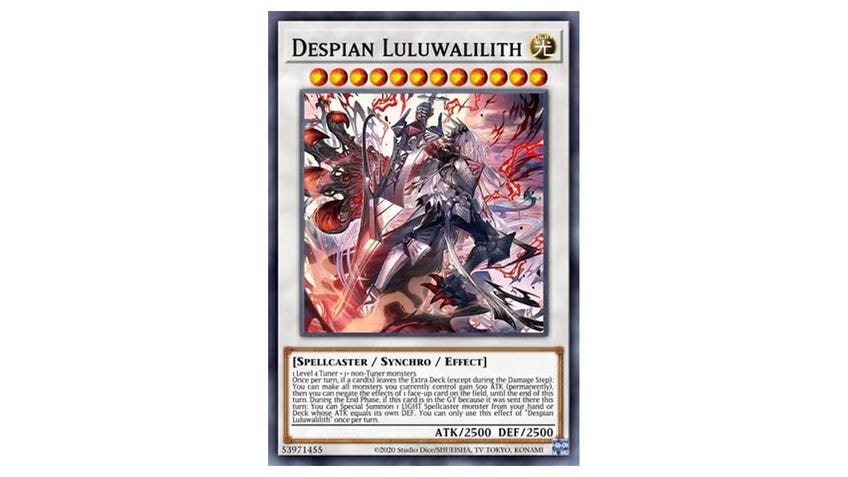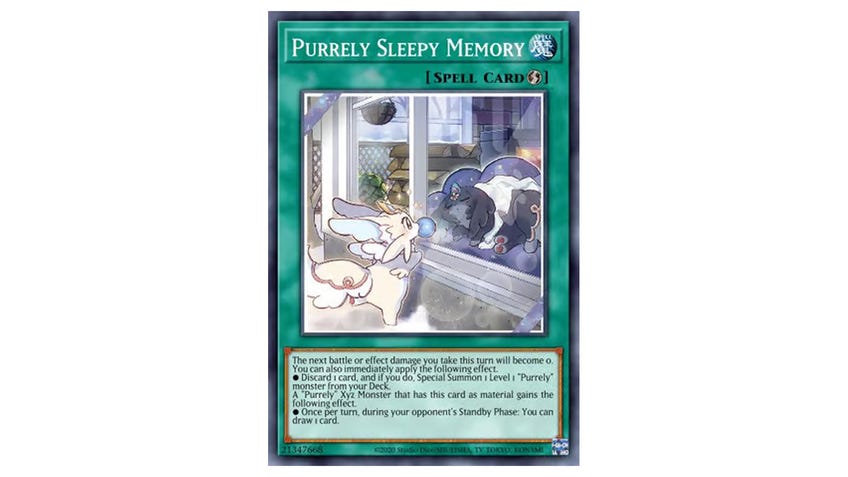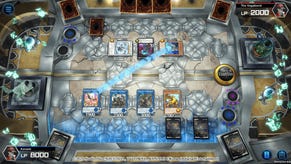The best Yu-Gi-Oh! decks to look for at this year's World Championships
From the tournament-tested Rikka and Kashtira to more unexpected hopefuls.
With less than a month to go until the Yu-Gi-Oh! World Championships descend on the Japanese capital and their home in the halls of Tokyo Big Sight, the question remains of which player and deck will come out on top in the prestigious event.
We just learned that Jessica Robinson walked away from the Yu-Gi-Oh! European Championships as its first female champion, with the recent American Championships one of the last major events standing between now and the fated weekend crowning our first World Champion since 2019.
That being said, at this stage, updated banlists and the state of play begin to give us some indication of what decks to expect competing for the top spot in August. The meta is in a healthy state, with a lot of variety in the decks able to compete at the highest level.
While the knowledge of which deck will ultimately come out on top is nearly impossible to predict, we can still speculate on the best decks in Yu-Gi-Oh! as we head towards the prestigious competition…
1. Rikka
A long-time favourite, and a Rikka-mended choice for Championship glory

…starting with the deck that just came out on top in a field of thousands at the recent European Championships. Not only was Jessica Robinson’s Rikka Sunavalon Therion deck the winner of the tournament’s 2023 incarnation, it was also the second year in a row that a British competitor and a Rikka deck had come out on top during the event, following last year's success for Marcus Patel with his unbeaten Rikka Sunavalon deck.
The deck has evolved in the year between the two victories, beyond the integration of another archetype into the deck - but not by much. Indeed, the Rikka and Sunavalon aspects of the deck remained nearly identical between the two lists, in part thanks to the deck’s relative underdog status throughout the past year compared to more attention-grabbing power decks like Despia and Kashtira helping it avoid negative impacts from the banlists. The integration of Therion into the deck is where it stands out - something Jessica explained in her deck video as being a counter to the broad state of the meta that can control the game and prevent interruptions (which this assists in thanks to their negation effects).
Indeed, a big contributing factor to the deck’s continued dominance is its control. While the Rikka monsters have the potential to flood the field with an array of powerful Link monsters, and through the likes of Princess have their own negation abilities, they are vulnerable to counters.
With a smaller core engine integrated into other decks such as this, however, weaknesses in the Rikka strategy can be overcome, turning any player of the deck into a formidable opponent when coupled with the ease at which the deck can remove pesky monsters using the likes of Rikka Konkon.
While the deck can be overshadowed in conversation for the best Yu-Gi-Oh! decks of the format, the European Championships showed just why Rikka remains a force to be reckoned with - and one not to be overlooked.
2. Kashtira
The popular kid’s choice, but can it go all the way?

Despite coming second in the recent European Championships, Kashtira still ultimately remains the Yu-Gi-Oh! deck to beat at the moment. Despite Rikka’s eventual victory, Kashtira accounted for the highest percentage of decks in the top 64 of the event - 30% - and was the most prominent deck in each of the following rounds before its eventual defeat. With good reason, too.
As we noted when previewing the best cards in the Photon Hypernova booster set, the flurry of support this deck has received elevated it to a near-untouchable state in the meta. By banishing your opponent’s cards facedown it was far harder to bring them back into the matchup - creating devastating scenarios for those forced to face up against this deck, even before considering their ability to control the board through effect negation via cards like Shangri-Ira.
Kashtira’s untouchable status has weakened somewhat in the months since due to the deck being targeted by Konami through the Yu-Gi-Oh! banlist. The limiting of the Arise-Heart Xyz monster that would often close out any combo - which saw Shangri-Ira utilising its effect to remove monsters from the game to clinical effect - even before considering the ban of the generic Rank 7 Xyz monster Number 89: Diablosis the Mind Hacker, reduced the options available to the deck alongside a considerable knock to its strength. Cracks started appearing in the deck’s consistency, removing the sheen it once held.
This remains the Yu-Gi-Oh! deck to beat going into the World Championships. But as this past weekend has shown, it’s far from unstoppable.
3. Branded Despia
Even with a banlist Expulsion, don’t count out Despia

Despite the loss of Branded Expulsion and its ability to tribute a Fusion monster to bring back two monsters to the field in the banlist, Branded Despia remains a deck to beware in the current format thanks to the new support the deck received in the recently-released Cyberstorm Access set. Luluwalilith gives it a synergetic way of negating monster effects alongside a permanent boost in attack that can turn the card into a mammoth to overcome, even ignoring the other powerful cards at its disposal in spite of a loss of consistency due to the loss of Expulsion.
Despia has access to all the Fallen of Albaz extra deck monsters - not just the powerhouse that is Mirrorjade the Iceblade Dragon, but the other Dragons such as Granguignol and Albion. With this on field, not only will your opponent have a hard time overcoming your field, but you have Branded Retribution to offer additional protection against your opponent’s plays.
What hurts Branded Despia against some of the other best Yu-Gi-Oh! decks of the current moment is its weakness to many common counters circulating the top decks of the game. The key strategies relying on bringing cards out of the deck by card effect make it vulnerable to Ash Blossom & Joyous Spring, a card currently played by pretty much every deck in the game that can stop Despia’s strategies in their tracks. Without a good way to play beyond this card’s activation, it’s game over.
If you can get past this? Despia has access to some of the strongest monsters in the game right now, and is as difficult as ever to play against.
4. Labrynth
Don’t get lost against this potential opponent

Even amongst intense competition, Labrynth stands strong by virtue of its status as the best Yu-Gi-Oh! control deck of the format. The most common variants rely heavily on backrow running almost half the deck on archetype-specific and game-slowing and counter trap cards. Combined with a lack of removal for such cards beyond Harpie’s Feather Duster in the current format, this deck is more sustainable and oppressive than one may expect.
The key to the deck’s success is building a board early and protecting it from penetration through its myriad trap cards - which themselves serve as a way to poke holes in your opponent’s strategy. It’s hard to discount any deck with a 3000 ATK creature like Lady Labrynth of the Silver Castle, which can not only easily Special summon itself from the hand but remain untouchable by card effects provided you control a set spell or trap card - never mind one that main deck many of the cards necessary to counter the top strategies of the day.
Thanks to running an array of high-ATK Dark monsters, the deck can even run cards like Eradicator Epidemic Virus to remove the threat of cards like Harpie’s Feather Duster, never mind the use of archetype-specific cards like Big Welcome Labrynth or powerful generic traps typically reserved for the Side Deck, like Evenly Matched.
Going first against a Labrynth player can at times feel like the only viable strategy to getting ahead of them and putting up a fighting chance before they build a board with the strength to lock you out of the game for good. No deck with this much control in a format less likely to run the cards necessary to counter against it can be discounted in search of the ultimate prize.
5. Spright/Vanquish Soul/Dragon Link/Purrely… Any Deck Has a Shot at Glory!
The field is wide open (and the Graveyard, and the Extra Deck…)

Ultimately, what makes this current format one of the most exciting in years is the balance in play within the current metagame. Casting eyes back to the dominance of single decks like Sky Striker or even Kashtira towards the start of this year (or, for older players looking for a bit of trauma, Dragon Rulers), it feels like any deck could win a major event at the moment. We haven’t even brought up the Runick deck here, or the Exosister deck that won the North American Remote Duel YCS held just one week before the recent European Championships.
In that tournament all four of the top decks were from different archetypes between Exosister, Mathmech @Ignister, Kashtira and Purrely - the recently-released archetype sleepwalking its opponents to defeat with the power of surprise and dreams (or, for the loser, nightmares).
Spright remains something to behold despite not quite being the dominant force it once was and, for fans of link monsters, Dragon Link has been boosted by an influx of players integrating the deck with Bystials thanks to its synergy with the attribute and searchability of Dragons within the traditional strategy.
And who’s to say an unexpected strategy couldn’t upset the competition and take home the top prize by sheer virtue of working around the common counters in the current meta? Part of the advantage to the variety to the current era of Yu-Gi-Oh! is that it’s all-but impossible to balance your deck to play to your own strengths while countering everyone else in the competition, leaving every deck at least vulnerable to some of the core strategies seeing at least semi-regular play.
Even the fact this is a World Championship shouldn’t be overlooked when considering which deck will come out on top this year. Rogue strategies could succeed, but with the chance of ultimate glory in a one-time event such as this, not even a standard regional or YCS event holds the same level of stakes as a competition such as this. Would you want to risk it all on an unproven strategy that could surprise your way to victory on the biggest stage of all, or play something more familiar?
Skill is the ultimate deciding factor more than merely running the best deck and being able to hold your own in a mirror match - and shouldn’t that be what we want ahead of an exciting return for World Championship competition?
The Yu-Gi-Oh! World Championships kick off on August 5th and 6th at Tokyo Big Sight. We can speculate on which deck may come out on top like this, but maybe the heart of the cards will be the true judge for victory this year.









